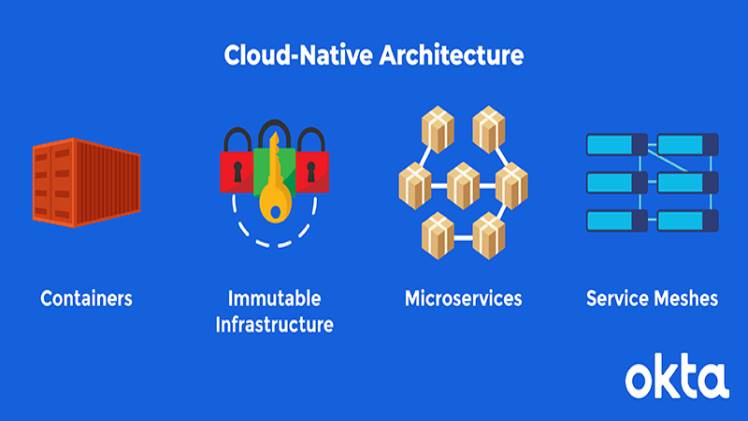Understanding the Basics of Cloud Native Application Architecture

Cloud-native application architecture combines DevOps practices with automation embedded across the software development lifecycle. It helps teams build faster and more reliable software while significantly accelerating the SDLC.
Cloud-native applications are built to be scalable, resilient, and easily managed. It is achieved by dynamically scaling out, automatically handling failure, and making adding or removing components as easy as possible.
Microservices
Microservices are small, self-contained, autonomous services that implement a single business capability within a bounded context. They can be written in a variety of languages and frameworks.
Microservice architecture is preferred for many companies looking to increase performance, reduce cost, and improve scalability. It benefits applications that need frequent updates, experience dynamic traffic patterns, or require near real-time communication.
It is a flexible and scalable approach that lets you adapt to changing needs, scale portions of the application independently, and use cloud resources more efficiently. It allows you to reduce your monthly cloud bill as you scale only those features that require more processing power and meet service-level agreements.
The ability to change small parts of the application without disrupting the whole application makes microservices more resilient. It enables your system to recover quickly when a service goes down.
It can improve user experiences, reduce downtime, and keep your business running at peak performance. Moreover, a microservices architecture is much more flexible, so you can easily add new features and functionality to your application.
Monolithic applications, on the other hand, are often difficult to maintain. They become complicated over time, and adding a new feature requires touching code in numerous places.
Containers
Containers are a popular method of packaging applications for deployment on virtual machines (VMs) or physical servers. They hold everything needed to run an application, including libraries and processes. They’re lightweight and allow you to encapsulate your entire application in a single package, which makes it easy to move and scale your software.
Cloud native application architecture are designed to leverage the cloud’s elasticity and agility, leveraging containerized and microservice-oriented architectures. This architecture reduces development times and delivers more reliable, secure, and scalable applications.
To support this architecture, container orchestrators manage containerized workloads and the lifecycle of those containers. These tools can be hosted or managed by the cloud provider, which is convenient for organizations that need to become more familiar with the container ecosystem.
Moreover, these systems can be deployed across multiple servers and are highly scalable. It lets you choose the services that are best suited for public or private clouds and migrate them as needed to cope with peak demand.
Finally, cloud-native apps conform to a “contract” that maximizes resilience by embracing predictable behaviors. It ensures that your application will perform as expected and not break unexpectedly.
Aside from containerization, cloud-native apps also embrace Infrastructure as Code (IaC) and automation of resource allocation. These practices help businesses reduce operational costs and transform IT teams into lean, focused groups aligned with business priorities.
Platform-as-a-Service (PaaS)
A Platform-as-a-Service (PaaS) is a cloud computing model providing everything developers need to build, run and manage applications. It includes servers, storage, data centers, networking resources, and various design, testing, and development tools.
This service enables development teams to develop and test applications quickly. It also allows them to collaborate with other developers and work remotely without physical hardware.
In addition, PaaS can support new programming languages and technologies as they become available, enabling organizations to incorporate new channels of technical growth into their businesses without affecting existing business processes. It is essential for industries such as banking or manufacturing, where technological change is a slow process, and companies need to be able to adopt new offerings without completely changing their business practices.
The key to a PaaS is ensuring that it meets the specific needs of the organization and its development teams. It also needs to be scalable, flexible, and secure. Choosing a suitable PaaS can be challenging, as there are many providers out there, and each one may offer different features and capabilities.
DevOps
DevOps is a set of cultural and collaborative practices that align development and operations teams to work in unison and focus on improving customer experience, speeding up innovation, and balancing security and operational needs. The term is often used to describe software development teams. Still, it also refers to the systems and admin who work with them in various roles (including release engineers, DBAs, network engineers, security professionals, and other IT subdisciplines).
A key component of cloud native application architecture is microservices. This architecture decomposes applications into small, independently operating services that map to smaller, independent development teams and allow frequent updates, scaling, and failover/restart without impacting other services.
These independent services are packaged as lightweight containers that can be deployed and scaled easily into different environments – on-premises, in the public cloud, or hybrid scenarios. This architecture allows teams to focus on building and delivering new features in a fast cadence rather than worrying about the infrastructure layers that can break down in a monolithic application.
Typically, teams use continuous integration and delivery (CI/CD) to automate these cloud-native applications’ build, testing, and deployment. It includes monitoring and logging to ensure that applications always work as expected.
The underlying philosophy behind DevOps is that the right culture, collaborative practices, and automation can align development and operations teams to deliver high-quality products faster, more reliably, and with less risk. It leads to higher customer satisfaction and increased loyalty, as customers experience fewer outages and a better user experience.


